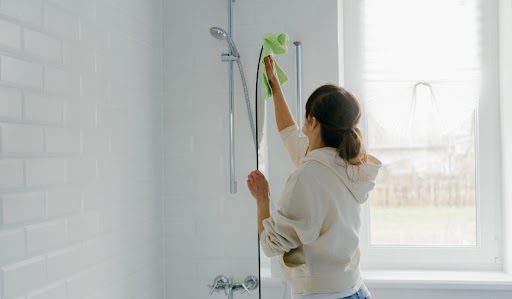Your bathroom is not just a mere unit for daily functioning, with little changes in how one uses it; it’s a sacred space for relaxation. However, with time, it can accumulate grime and lose its lustre. This guide aims to not only thoroughly clean your bathroom but also elevate it into a tranquil retreat where you can unwind. Let’s embark on a comprehensive journey to revitalise your bathroom.
See also:How to deep clean your house
Declutter for clarity
Decluttering sets the stage for a transformative clean. Begin by emptying every drawer, shelf and cabinet. This provides a blank canvas and allows you to identify areas that need attention. Sort items into categories: ‘keep’, ‘discard’, ‘recycle’ and ‘donate’. Like a curator arranging an exhibit, this process offers clarity on your bathroom essentials. Don’t forget to check expiration dates on cosmetics and medications, ensuring a safe and healthy environment. Invest in storage solutions like drawer dividers and clear containers to maintain an organised space. Regular decluttering should become a habit, reflecting an organised mind and a tranquil atmosphere.
Select the perfect cleaning arsenal
Choosing the right cleaning agents is crucial for a thorough cleaning. An all-purpose cleaner is versatile, but ensures it’s safe for countertops and tiles and effective against soap scum, mould and mildew. For the toilet, opt for a disinfecting cleaner to eliminate germs. Glass surfaces require a streak-free cleaner for a crystal-clear finish. Tiles and grout may need a specialised cleaner to combat dirt and mildew. Disinfectant sprays or wipes are crucial for high-touch areas, ensuring a hygienic environment. Always prioritise environmentally-friendly options for a spa-like, eco-conscious atmosphere.
Revitalise ceilings and walls
The often-overlooked ceiling and walls are exposed to humidity and can harbour mould and mildew. Dust off corners and light fixtures to prepare for cleaning. A mixture of warm water and dish soap, or a solution with white vinegar for tougher spots, is effective for general cleaning. Gently scrub from top to bottom, using a soft sponge or cloth. For higher areas, consider using an extended brush or mop. Stubborn stains can be tackled with a paste of baking soda and water. Rinse thoroughly to remove any residue and ensure proper ventilation for a fresh, mould-free environment.
Deep clean the toilet
A clean toilet is crucial for hygiene and aesthetics. Start by flushing to wet the surface. Apply a toilet cleaner under the rim and let it sit to break down stains and kill germs. Use a toilet brush to thoroughly scrub all areas, including hard-to-reach spots. Remember the exterior and flush handle, as these are high-touch areas. Wipe down the tank to eliminate accumulated dust and grime. After thorough scrubbing, flush again to rinse the bowl. Maintain cleanliness between deep cleans by using a toilet bowl cleaner tablet.
Revive your shower and bathtub
These areas are the epitome of relaxation but are also prone to mould and mildew. Before applying any cleaner, dry scrub the surfaces to loosen soap scum and dirt. Choose a cleaning solution based on the specific issues – vinegar for hard water stains and a baking soda paste for stubborn spots. Scrub every nook and cranny, paying special attention to grout lines and faucet areas. An old toothbrush is perfect for intricate spaces. Rinse away all cleaning agents and dry the surfaces to prevent water spots and mould growth. Consider using a squeegee after every use to maintain a sparkling finish.
Refresh shower curtains and accessories
Shower curtains play a dual role in providing privacy and protecting your bathroom. Inspect them for any damage or mould. Machine-washable curtains can be cleaned with warm water, detergent, baking soda and vinegar. For non-machine-washable curtains, hand washing in warm, soapy water is effective. Air dry to maintain curtain integrity. Don’t forget to clean the curtain rings and the shower rod for a complete refresh.
Sink and countertop deep clean
Your sink and countertop are the centre of your daily routine. Start by clearing the countertop to ensure thorough cleaning. Use a mild detergent or a mixture of water and vinegar to scrub the sink and faucet areas. Stubborn stains can be tackled with a baking soda paste. Wipe down the entire countertop, paying extra attention to corners and edges. Faucet handles, being high-touch areas, should be meticulously cleaned. Rinse and dry to achieve a streak-free, gleaming finish.
Renew hand towels
Hand towels, often overlooked, play a significant role in your bathroom’s functionality and aesthetic. Assess them for wear and stains. Wash in warm water with detergent and vinegar to maintain their softness and cleanliness. Ensure thorough drying to prevent mould. Fold and store in a clean, dry area for ready use.
Revitalise bathroom floors
Neglecting the floor can lead to safety hazards and unsightly stains. Sweep or vacuum to remove loose debris. Choose a mild detergent mixed with water for general cleaning, paying extra attention to grout lines on tiled floors. Mop thoroughly, ensuring complete coverage. Dry the floor to prevent slips and watermarks.
Maintain your cleaning tools
Cleaning tools work hard to keep your bathroom spotless, but they need care too. Rinse them immediately after use to remove dirt and residues. Deep clean with water and vinegar for tools like brushes and mops. Launder cleaning cloths separately in hot water to remove deep-seated dirt and germs. Ensure thorough drying to prevent mould growth. Store your tools in a dry, well-ventilated area for their next cleaning mission.
Create a spa-like ambiance
After the deep clean, add a touch of luxury with aromatherapy. Using essential oil diffusers is great for relaxation like that of eucalyptus and lavender. Incorporate a well-placed plant or candle to elevate the ambiance, providing both aesthetic and aromatic pleasures.
With these detailed steps, your bathroom will not only be thoroughly clean but also transformed into a spa-like sanctuary. A deep clean isn’t just about removing dirt; it’s about creating an environment that promotes tranquillity and rejuvenation. Follow these tips to enjoy a revitalised and refreshed bathroom space that elevates your daily routine.
FAQs
How often should I deep clean my bathroom?
It's recommended to deep clean your bathroom at least once a month. However, high-traffic bathrooms or those prone to moisture may benefit from more frequent deep cleaning.
Can I use natural cleaning agents instead of commercial products?
Absolutely! Natural cleaners like vinegar, baking soda and lemon juice can be highly effective in cleaning various bathroom surfaces. They are eco-friendly and safe for both your family and the environment.
What's the best way to prevent mould and mildew growth in the bathroom?
Adequate ventilation is crucial in preventing mould and mildew. Use exhaust fans or open windows after showering. Regularly wipe down wet surfaces and invest in mould-resistant materials where possible.
How can I keep my bathroom smelling fresh after cleaning?
After a deep clean, consider using essential oil diffusers with scents like lavender or eucalyptus for a natural and refreshing aroma. Regularly wash towels and mats and ensure good airflow in the bathroom.
What's the proper way to clean grout between tiles?
For cleaning the grout, create a paste using baking soda and water. Apply it to the grout gaps, scrub with a brush and rinse properly. For stubborn stains, consider a specialised grout cleaner.
How can I prevent water spots on glass shower doors?
After each shower, use a squeegee to remove excess water from the glass doors. This simple step can significantly reduce the buildup of water spots and keep your shower looking crystal clear.
Are there any specific considerations for cleaning delicate bathroom fixtures?
Delicate fixtures like antique faucets or decorative mirrors may require special care. Use a mild cleaner and a soft cloth to avoid any potential damage. Always refer to the manufacturer's guidelines if available.
Can I use the same cleaning tools for the entire bathroom?
It's recommended to have dedicated cleaning tools for different areas of the bathroom. For example, use separate clothes for the toilet and sink to prevent cross-contamination. Wash and sanitise your cleaning tools after each use.
What should I do if I discover a leak or water damage during cleaning?
If you find any signs of a leak or water damage, it's essential to address it promptly. Turn off the water supply if necessary and consider seeking professional help to repair the issue to prevent further damage.
How can I maintain the results of a deep clean between sessions?
Regular upkeep is key. Wipe down surfaces after use, keep the bathroom well-ventilated and promptly address any spills or stains. Implement a routine cleaning schedule to ensure a consistently clean and inviting space.
| Got any questions or point of view on our article? We would love to hear from you. Write to our Editor-in-Chief Jhumur Ghosh at jhumur.ghosh1@housing.com |







